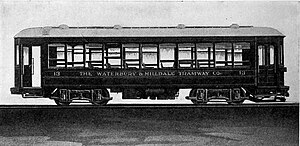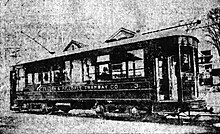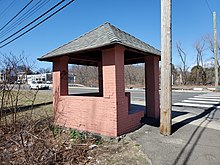
Southington is a town in Hartford County, Connecticut, United States. The town is part of the Capitol Planning Region. As of the 2020 United States Census, it had a population of 43,501. Southington contains the villages of Marion, Milldale, and Plantsville.
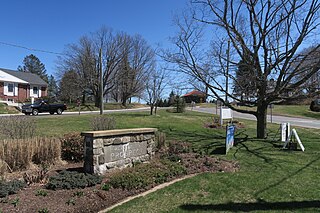
Prospect is a town in the Naugatuck Valley Planning Region, Connecticut, United States. It is a suburb of the nearby city of Waterbury to its north, and is on the north-eastern fringes of the New York metropolitan area. The population was estimated to be 9,401 in 2020. Prospect is part of the Waterbury NECTA and of the historical New Haven County. Prospect is also a member of the regional health district Chesprocott, along with Cheshire and Wolcott.

Wolcott is a town in New Haven County, Connecticut, United States. The town is part of the Naugatuck Valley Planning Region. It is primarily residential, with a population of 16,142 as of the 2020 United States Census.

Meriden is a city in New Haven County, Connecticut, United States, located halfway between the regional cities of New Haven and Hartford. The city is part of the South Central Connecticut Planning Region. In 2020, the population of the city was 60,850.

Route 66 is a Connecticut state highway running from Meriden to Windham, serving as an alternate east–west route to US 6 through east-central Connecticut.
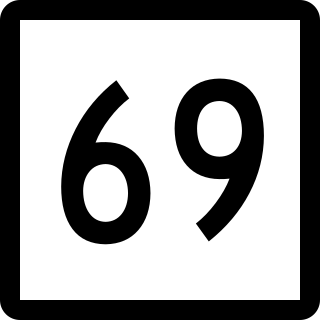
Route 69 is a primary north–south state highway in the U.S. state of Connecticut connecting the city of New Haven to the city of Bristol in the western part of Greater Hartford, passing through Greater Waterbury along the way. The route extends north of Bristol as a secondary route into the town of Burlington. Route 69 is 35.16 miles (56.58 km) in total length.

Route 70 is a 10.92-mile-long (17.57 km) state highway in the U.S. state of Connecticut, connecting the towns of Cheshire and Meriden. The western half of the route is an important link between the Greater New Haven and the Greater Waterbury areas and is part of the state primary highway system. It runs in a “U” Shaped Pattern.

CT Transit is a public transportation bus system serving many of the metropolitan areas and their surrounding suburbs in state of Connecticut. CT Transit is a division of the Connecticut Department of Transportation, although it contracts a number of private companies for most of its operations. CT Transit began operations in 1976 as Connecticut Transit after the Connecticut DOT's acquisition of the Connecticut Company that year. Although initially serving only the Hartford, New Haven, and Stamford areas, various local companies and private operators became part of the CT Transit system from the 1970s to the early-2000s. CT Transit's service now extends across much of Connecticut, although specifically around the cities of Bristol, Hartford, Meriden, New Britain, New Haven, Stamford, Wallingford and Waterbury. In 2015, CT Transit began operation of CT Fastrak, the first bus rapid transit system in Connecticut and the second in New England.

Connecticut Route 10 is a state highway that runs between New Haven and the state line near Granby. It continues north of the state line as Massachusetts Route 10, which in turn continues directly to New Hampshire Route 10.

The Connecticut Company was the primary electric street railway company in the U.S. state of Connecticut, operating both city and rural trolleys and freight service. It was controlled by the New York, New Haven and Hartford Railroad, which also controlled most steam railroads in the state. After 1936, when one of its major leases was dissolved, it continued operating streetcars and, increasingly, buses in certain Connecticut cities until 1976, when its assets were purchased by the state government.
The Connecticut League, also known as the Connecticut State League, was a professional baseball association of teams in the state of Connecticut. The league began as offshoot of the original Connecticut State League, which dates back as far as 1884. In 1891, the Connecticut State League included the Ansonia Cuban Giants, a team made up of entirely African-American ballplayers, including future Hall of Famers Frank Grant and Sol White. In 1902, it was a Class D league with teams in eight cities. In 1905, the league became Class B, which lasted until 1913, when the league became the Eastern Association due to several teams outside of the state entering the league. Also a Class B league, it survived two more seasons, then folded after the 1914 season.
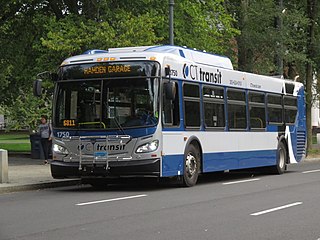
CT New Haven is the second largest division of Connecticut Transit, providing service on 24 routes in 19 towns within the Greater New Haven and Lower Naugatuck River Valley areas, with connections to other CT Transit routes in Waterbury and Meriden, as well as connections to systems in Milford and Bridgeport at the Connecticut Post Mall.
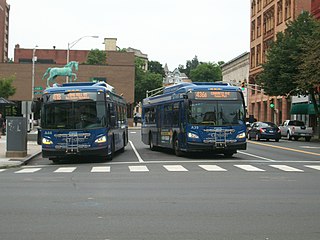
The Northeast Transportation Company is the operator of local bus service in the cities of Waterbury, Naugatuck, Meriden, and Wallingford, operating under contract to Connecticut Transit.
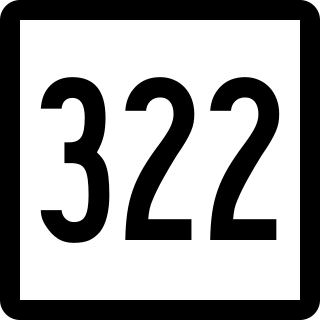
Route 322 is a state highway in west central Connecticut, running from Wolcott to Southington.

CTfastrak is a regional bus rapid transit system currently operating between downtown Hartford and Downtown New Britain station in New Britain in central Connecticut. Operated by Connecticut Transit, it is the first bus rapid transit system in Connecticut and the second in New England after the MBTA Silver Line. CTfastrak opened on March 28, 2015 after fifteen years of planning and three years of construction.

Waterbury station is a commuter rail stop on the Waterbury Branch of the Metro-North Railroad's New Haven Line, located on Meadow Street in Waterbury, Connecticut. It is the northern terminus of the Waterbury Branch.
The Bridgeport Traction Company was a streetcar transit company in the area around Bridgeport, Connecticut. The company was incorporated in 1893 through the consolidation of the Bridgeport Horse Railroad Company, Bridgeport Railway Company, and the East End Railway Company. The East End Railway Company was established in 1895 as the Bridgeport and West Stratford Horse Railroad Company. The Bridgeport Horse Railroad Company was incorporated in 1864. The Bridgeport Railway Company was formed in 1893. At the time, streetcars were a more affordable form of transportation for those commuting between Bridgeport and Norwalk. Using streetcars to get to their destination was half the price of using the train. In 1899 president Andrew Radel formed a company that was intended to control the world's oyster trade.

The New York and Stamford Railway was a streetcar line that connected the Westchester County suburbs of New Rochelle, Larchmont, Mamaroneck, Harrison, Rye, and Port Chester, with the Connecticut suburbs of Greenwich and Stamford. The company was formed in 1901 when the New York, New Haven and Hartford Railroad combined the Larchmont Horse Railway Company with the Port Chester Street Railroad Company. The Larchmont Horse Railway Company was founded in 1888 by the Larchmont Manor Company to construct a line from the New York, New Haven and Hartford Railroad Larchmont train station to its development 1.2 miles from town. The line was rebuilt for electric operation and extended to Harrison in 1901. The Port Chester Street Railroad opened in 1898 serving Port Chester, New York. The trolley line was soon extended west through Rye to Harrison in 1901. The two companies were merged that summer to form the New York and Stamford Railway. Trackage rights over the Westchester Electric Railroad were obtained for access to New Rochelle.
Connecticut Railway and Lighting Company was a streetcar and bus transit operator serving the region around Bridgeport, Norwalk, Derby, New Britain and Waterbury, Connecticut. It was formed in 1901 by United Gas Improvement Company of Philadelphia to manage the streetcar operations of the Connecticut Light and Power Company, which at the time included Central Railway and Electric Company, Norwalk Street Railway, and the Waterbury Traction Company. The newly formed Connecticut Railway and Lighting acquired Bridgeport Traction Company, Derby Street Railway, Milford Street Railway, Shelton Street Railway, Meriden, Southington and Compounce Tramway Company, and the Cheshire Street Railway. Connecticut Railway and Lighting was leased to the Consolidated Railway and in turn the Connecticut Company between 1906 and 1936. Streetcar operations were discontinued in 1937 when all lines were converted to bus. Transit operations continued until 1972, when all remaining bus operations were suspended and taken over by Connecticut Transit, except in Bridgeport- by the Greater Bridgeport Transit District in 1975.

The Meriden, Waterbury, and Connecticut River Railroad was a railroad in the state of Connecticut. The charter, originally granted in 1871 to the Meriden and Cromwell Railroad, was obtained by Meriden residents and construction began in 1883. The line opened between the city of Meriden, Connecticut, and the Connecticut River in Cromwell, Connecticut, in 1885. An extension to Waterbury, Connecticut, was completed in 1888 as the Meriden and Waterbury Railroad, and the two companies merged to form the Meriden, Waterbury and Connecticut Railroad.
